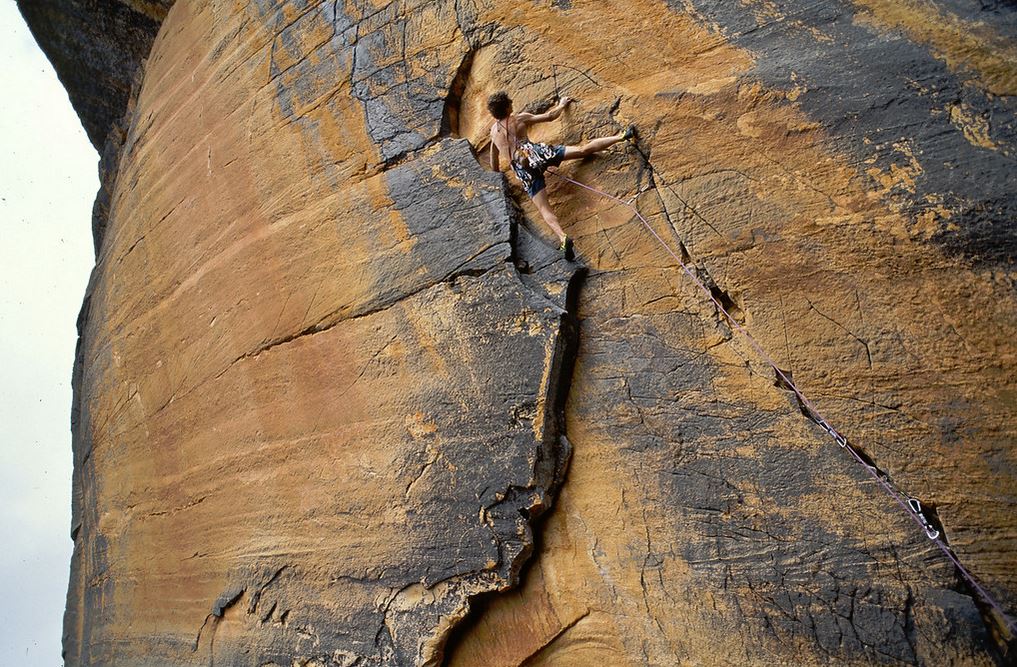To all of our loyal wholesale and retail customers it is with a great deal of regret that Open Spaces Publishing has made the decision to halt work on all of our planned rock climbing and bushwalking titles for the Grampians National Park and at nearby Mt Arapiles. Our business moved to Natimuk in the… Continue reading Parks Victoria Halts New Grampians And Arapiles Guidebooks
Tag: rockclimbing
Is This Australia’s Oldest Rock Climbing Photograph?
The Grampians have been in the climbing news a lot lately after Parks Victoria initiated the world’s largest rock climbing bans (over 50% of the region’s best climbing) and with no consultation with the climbing community. To say these have been tough times for the climbing community is an understatement. Coincidentally I have just finished… Continue reading Is This Australia’s Oldest Rock Climbing Photograph?
The First Ascent of Blimp
At the end of the academic year 1968 at RMIT, I looked for a new outdoor activity, so I met Fred Langenhorst and Rein Kamar from the bushwalking club in the college café. ‘Hi Bruno, would you like to do a rock climbing course with us?’ ‘Yeah, I would like that.’ The introductory course with… Continue reading The First Ascent of Blimp
Law Unto Himself
Last Monday Open Spaces in conjunction with the Victorian Climbing Club saw the release of Michael Law’s autobiography (of sorts) at Thousand £ Bend at Little Lonsdale Street. It was a wild Melbourne night of heavy rain and hail, yet despite this almost 70 people turned out to listen to one of Australian climbing’s most… Continue reading Law Unto Himself
The Art of Belay
So what sort of belayer are you? Are you a fashionable belayer? A safe belayer. Attentive or casual? Which belay devices do you use? Here are a few of my favorite belay scenarios, dug out of my dusty archives.
The Rust Bucket
This new Grampians sport-climbing cliff is located just near the Mount of Olives, a couple of minutes walk off the trail linking the Stapylton Campground with the Mt Stapylton Amphitheatre (total walk-in time is about 20min). The cliff is very short (only 12m or so) but the climbing is steep on generally good pocketed rock.… Continue reading The Rust Bucket
Arapiles Pocket Companion: Out Soon
It’s been five years since Simon Mentz and I released our Arapiles Selected Climbs guide. Although well-received by the climbing community, the guide did have one major problem. Weighing in at a hefty 715g meant that this was not something you could easily carry up The Bard or Skink. Great for bench-pressing but not really… Continue reading Arapiles Pocket Companion: Out Soon
Mountain Magazine: Brave New World
I bought my first copy of Mountain magazine at Bushgear in Hardware Lane. It was the January 1974 (no 31) edition which, due to a six month sea voyage, didn’t reach our shores until almost September. It cost 30 pence in the UK, $1.25 in the United States and $3.50 here in Australia. I remember… Continue reading Mountain Magazine: Brave New World
Koh Yao Noi, Stepping Back in Time
It’s hard to believe that 20 years have passed since I first climbed in Thailand. Of course back in 1992 Phra-Nang was nothing like it is today. Tonsai was completely undeveloped with just a few rough huts set back in the jungle. Railay had a bunch of basic bungalow systems and it was only the… Continue reading Koh Yao Noi, Stepping Back in Time
Mike Graham; a Day at Arapiles (1980)
California-based climber Mike Graham first visited Arapiles in 1980. He and his partner, Wendy, flew into Melbourne and stayed at my parents house in Lilydale. I think it was a relief for my parents to see that I actually had some ‘normal’ friends rather than the weird riff-raff that usually crashed on our lounge room… Continue reading Mike Graham; a Day at Arapiles (1980)









